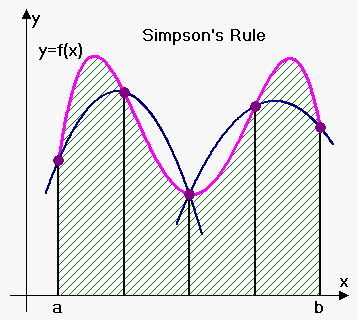Simpson's Rule
An idea of the Simpson's rule is in following: approximate curve by parabola and then find area of parabola (it is easy to do because we know antiderivative of quadratic function).
Again we divide $$${\left[{a},{b}\right]}$$$ into $$${n}$$$ subintervals of equal length $$$\Delta{x}=\frac{{{b}-{a}}}{{n}}$$$, and also require $$${n}$$$ to be even number.
Then on each consecutive pair of intervals we approximate the curve $$${y}={f{{\left({x}\right)}}}$$$ by a parabola. If $$${y}_{{i}}={f{{\left({x}_{{i}}\right)}}}$$$, then $$${P}_{{i}}={\left({x}_{{i}},{y}_{{i}}\right)}$$$ is the point on the curve lying above $$${x}_{{i}}$$$.
A typical parabola passes through three consecutive points $$${P}_{{i}}$$$, $$${P}_{{{i}+{1}}}$$$ and $$${P}_{{{i}+{2}}}$$$.
First we find equation of parabola that passes through points $$${\left({x}_{{0}},{y}_{{0}}\right)}$$$, $$${\left({x}_{{1}},{y}_{{1}}\right)}$$$ and $$${\left({x}_{{2}},{y}_{{2}}\right)}$$$.
Also note that $$${x}_{{1}}={x}_{{0}}+\Delta{x}$$$ and $$${x}_{{2}}={x}_{{0}}+{2}\Delta{x}$$$.
Equation of any parabola has form $$${y}={A}{{x}}^{{2}}+{B}{x}+{C}$$$ and so area under parabola from $$${x}={x}_{{0}}$$$ to $$${x}={x}_{{2}}={x}_{{0}}+{2}\Delta{x}$$$ is
$$${S}={\int_{{{x}_{{0}}}}^{{{x}_{{0}}+{2}\Delta{x}}}}{\left({A}{{x}}^{{2}}+{B}{x}+{C}\right)}{d}{x}={\left(\frac{{A}}{{3}}{{x}}^{{3}}+\frac{{B}}{{2}}{{x}}^{{2}}+{C}{x}\right)}{{\mid}_{{{x}_{{0}}}}^{{{x}_{{0}}+{2}\Delta{x}}}}=$$$
$$$={\left(\frac{{A}}{{3}}{{\left({x}_{{0}}+{2}\Delta{x}\right)}}^{{3}}+\frac{{B}}{{2}}{{\left({x}_{{0}}+{2}\Delta{x}\right)}}^{{2}}+{C}{\left({x}_{{0}}+{2}\Delta{x}\right)}\right)}-{\left(\frac{{A}}{{3}}{{x}_{{0}}^{{3}}}+\frac{{B}}{{2}}{{x}_{{0}}^{{2}}}+{C}{x}_{{0}}\right)}=$$$
$$$={2}{A}\Delta{x}{{x}_{{0}}^{{2}}}+{4}{A}{{\left(\Delta{x}\right)}}^{{2}}{x}_{{0}}+\frac{{8}}{{3}}{A}{{\left(\Delta{x}\right)}}^{{3}}+{2}{B}\Delta{x}{x}_{{0}}+{2}{B}{{\left(\Delta{x}\right)}}^{{2}}+{2}{C}\Delta{x}=$$$
$$$=\frac{{\Delta{x}}}{{3}}{\left({A}{\left({6}{{x}_{{0}}^{{2}}}+{12}\Delta{x}{x}_{{0}}+{8}{A}{{\left(\Delta{x}\right)}}^{{2}}\right)}+{B}{\left({6}{x}_{{0}}+{6}\Delta{x}\right)}+{6}{C}\right)}$$$.
Additionally parabola should pass through points $$${P}_{{0}}={\left({x}_{{0}},{y}_{{0}}\right)}$$$, $$${P}_{{1}}={\left({x}_{{1}},{y}_{{1}}\right)}$$$ and $$${P}_{{2}}={\left({x}_{{2}},{y}_{{2}}\right)}$$$ (recall that $$${x}_{{1}}={x}_{{0}}+\Delta{x}$$$ and $$${x}_{{2}}={x}_{{0}}+{2}\Delta{x}$$$), so
$$${\left\{\begin{array}{c}{y}_{{0}}={A}{{x}_{{0}}^{{2}}}+{B}{x}_{{0}}+{C}\\{y}_{{1}}={A}{{\left({x}_{{0}}+\Delta{x}\right)}}^{{2}}+{B}{\left({x}_{{0}}+\Delta{x}\right)}+{C}\\{y}_{{2}}={A}{{\left({x}_{{0}}+{2}\Delta{x}\right)}}^{{2}}+{B}{\left({x}_{{0}}+{2}\Delta{x}\right)}+{C}\\ \end{array}\right.}$$$
From this we have that
$$${y}_{{0}}+{4}{y}_{{1}}+{y}_{{2}}=$$$
$$$={A}{{x}_{{0}}^{{2}}}+{B}{x}_{{0}}+{C}+{4}{\left({A}{{\left({x}_{{0}}+\Delta{x}\right)}}^{{2}}+{B}{\left({x}_{{0}}+\Delta{x}\right)}+{C}\right)}+{A}{{\left({x}_{{0}}+{2}\Delta{x}\right)}}^{{2}}+{B}{\left({x}_{{0}}+{2}\Delta{x}\right)}+{C}=$$$
$$$={A}{\left({6}{{x}_{{0}}^{{2}}}+{12}\Delta{x}{x}_{{0}}+{8}{{\left(\Delta{x}\right)}}^{{2}}\right)}+{B}{\left({6}{x}_{{0}}+{6}\Delta{x}\right)}+{6}{C}$$$.
If we know multiply both sides of equality by $$$\frac{{\Delta{x}}}{{3}}$$$ we will obtain that
$$$\frac{{\Delta{x}}}{{3}}{\left({y}_{{0}}+{4}{y}_{{1}}+{y}_{{2}}\right)}=\frac{{\Delta{x}}}{{3}}{\left({A}{\left({6}{{x}_{{0}}^{{2}}}+{12}\Delta{x}{x}_{{0}}+{8}{{\left(\Delta{x}\right)}}^{{2}}\right)}+{B}{\left({6}{x}_{{0}}+{6}\Delta{x}\right)}+{6}{C}\right)}$$$.
But right side is exactly area $$${S}$$$ under parabola.
Therefore, $$${S}=\frac{{\Delta{x}}}{{3}}{\left({y}_{{0}}+{4}{y}_{{1}}+{y}_{{2}}\right)}$$$.
Similarly, it can be shown that the area under parabola through $$${P}_{{2}}$$$, $$${P}_{{3}}$$$ and $$${P}_{{4}}$$$ from $$${x}={x}_{{2}}$$$ to $$${x}={x}_{{4}}$$$ is $$$\frac{{\Delta{x}}}{{3}}{\left({y}_{{2}}+{4}{y}_{{3}}+{y}_{{4}}\right)}$$$.
In general, area under parabola through $$${P}_{{i}}$$$, $$${P}_{{{i}+{1}}}$$$, $$${P}_{{{i}+{2}}}$$$ from $$${x}={x}_{{i}}$$$ to $$${x}={x}_{{{i}+{2}}}$$$ is $$$\frac{{\Delta{x}}}{{3}}{\left({y}_{{i}}+{y}_{{{i}+{1}}}+{y}_{{{i}+{2}}}\right)}$$$.
Summing areas under parabolas on each subinterval we will obtain that $$${\int_{{a}}^{{b}}}{f{{\left({x}\right)}}}{d}{x}\approx\frac{{\Delta{x}}}{{3}}{\left({y}_{{0}}+{4}{y}_{{1}}+{y}_{{2}}\right)}+\frac{{\Delta{x}}}{{3}}{\left({y}_{{2}}+{4}{y}_{{3}}+{y}_{{4}}\right)}+\ldots+\frac{{\Delta{x}}}{{3}}{\left({y}_{{{n}-{2}}}+{4}{y}_{{{n}-{1}}}+{y}_{{n}}\right)}$$$.
Simpson's Rule. $$${\int_{{a}}^{{b}}}{f{{\left({x}\right)}}}{d}{x}\approx{S}_{{n}}=\frac{{\Delta{x}}}{{3}}{\left({y}_{{0}}+{4}{y}_{{1}}+{2}{y}_{{2}}+{4}{y}_{{3}}+{2}{y}_{{4}}+\ldots+{2}{y}_{{{n}-{2}}}+{4}{y}_{{{n}-{1}}}+{y}_{{n}}\right)}$$$.
where $$${n}$$$ is even and $$$\Delta{x}=\frac{{{b}-{a}}}{{n}}$$$.
Note the pattern of coeffcients: 1,4,2,4,2,4,2,4,2,...,4,2,4,2,4,2,4,1.
Example 1. Use the Simpson's Rule to approximate value of $$${\int_{{1}}^{{2}}}\frac{{1}}{{{x}}^{{2}}}{d}{x}$$$ with $$${n}={8}$$$.
Here $$${a}={1}$$$, $$${b}={2}$$$, $$${f{{\left({x}\right)}}}=\frac{{1}}{{{x}}^{{2}}}$$$ and $$${n}={8}$$$. So, $$$\Delta{x}=\frac{{{b}-{a}}}{{n}}=\frac{{{2}-{1}}}{{8}}={0.125}$$$.
So, $$${\int_{{1}}^{{2}}}\frac{{1}}{{x}}{\left({d}{x}\right)}\approx{S}_{{n}}=$$$
$$$=\frac{{{0.125}}}{{3}}{\left({f{{\left({1}\right)}}}+{4}{f{{\left({1.125}\right)}}}+{2}{f{{\left({1.25}\right)}}}+{4}{f{{\left({1.375}\right)}}}+{2}{f{{\left({1.5}\right)}}}+{4}{f{{\left({1.625}\right)}}}+{2}{f{{\left({1.75}\right)}}}+{4}{f{{\left({1.875}\right)}}}+{f{{\left({2}\right)}}}\right)}=$$$
$$$=\frac{{0.125}}{{3}}{\left(\frac{{1}}{{{1}}^{{2}}}+\frac{{4}}{{{\left({1.125}\right)}}^{{2}}}+\frac{{2}}{{{\left({1.25}\right)}}^{{2}}}+\frac{{4}}{{{\left({1.375}\right)}}^{{2}}}+\frac{{2}}{{{\left({1.5}\right)}}^{{2}}}+\frac{{4}}{{{\left({1.625}\right)}}^{{2}}}+\frac{{2}}{{{\left({1.75}\right)}}^{{2}}}+\frac{{4}}{{{\left({1.875}\right)}}^{{2}}}+\frac{{1}}{{{2}}^{{2}}}\right)}\approx{0.5000299}.$$$
True value of integral is $$${I}={\int_{{1}}^{{2}}}\frac{{1}}{{{x}}^{{2}}}{d}{x}={0.5}$$$. As can be seen Simpson's rule gave very good approximation.
When we approximate integral we will always have some error: $$${E}={\int_{{a}}^{{b}}}{f{{\left({x}\right)}}}{d}{x}-{A}{p}{p}$$$ where $$${A}{p}{p}$$$ is approximation and $$${E}$$$ is error.
Error Bound for Simpson's Rule. Suppose $$${\left|{{f}}^{{{\left({4}\right)}}}{\left({x}\right)}\right|}\le{M}$$$ for $$${a}\le{x}\le{b}$$$ then $$${\left|{E}\right|}\le\frac{{{M}{{\left({b}-{a}\right)}}^{{5}}}}{{{180}{{n}}^{{4}}}}$$$.
Example 2. How large should we take $$${n}$$$ in order to guarantee that the Simpson's Rule approximation for $$${\int_{{1}}^{{2}}}\frac{{1}}{{{x}}^{{2}}}{d}{x}$$$ are accurate to within 0.0002?
Here $$${a}={1}$$$, $$${b}={2}$$$, $$${f{{\left({x}\right)}}}=\frac{{1}}{{{x}}^{{2}}}$$$.
Then $$${f{'}}{\left({x}\right)}=-\frac{{2}}{{{x}}^{{3}}}$$$, $$${f{''}}{\left({x}\right)}=\frac{{6}}{{{x}}^{{4}}}$$$, $$${f{'''}}{\left({x}\right)}=-\frac{{24}}{{{x}}^{{5}}}$$$ and $$${{f}}^{{{\left({4}\right)}}}{\left({x}\right)}=\frac{{120}}{{{x}}^{{6}}}$$$.
Therefore $$${\left|{{f}}^{{{\left({4}\right)}}}{\left({x}\right)}\right|}\le{120}$$$ for $$${1}\le{x}\le{2}$$$.
Thus, $$$\frac{{{120}{{\left({2}-{1}\right)}}^{{5}}}}{{{180}{{n}}^{{4}}}}<{0.0002}$$$ or $$${{n}}^{{4}}>\frac{{120}}{{{180}\cdot{0.0002}}}=\frac{{1}}{{{0.0003}}}$$$.
So, $$${n}>\frac{{1}}{{{\sqrt[{{4}}]{{{0.0003}}}}}}\approx{7.6}$$$.
So, we need to take $$${n}={8}$$$ (remember $$${n}$$$ must be even).
This is much better then $$${n}={36}$$$ for the midpoint rule and $$${n}={51}$$$ for the trapezoidal rule.
